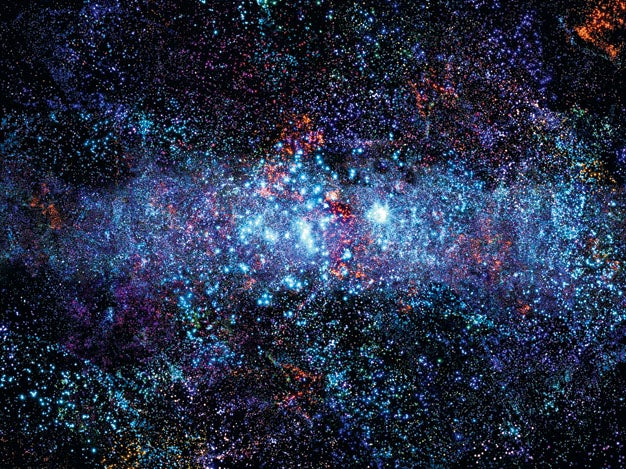Tips for Replicating Outer Space Shots
Learn how a table lamp can capture the universe

Are you hankering for an interesting subject for your next photo adventure? How about something light years away? Swiss photographer Fabian Oefner read Stephen Hawking’s popular treatise on recent advances in theoretical physics, The Universe in a Nutshell, and felt challenged to find universal truths—as Hawking does so well—in realities that are surprisingly close to home.
The result is Oefner’s series of images titled “Nebulae,” all of which, like the example above, could easily be taken for images made from the outer reaches of our solar system by the Hubble Space Telescope.
But no, this image doesn’t depict actual galaxies. Oefner’s subjects were the glowing tips of a fiber-optic table lamp, photographed against black with a 1:2 macro lens.
If you’d like to attempt a similar photo, get the right fiber-optic lamp. They’re available online and in lighting stores at prices starting at about $10. Look for one with black fiber-optic strands—only the tips should glow. The best will let you adjust color and sit on a black base. (If yours doesn’t, paint it black.) Consider buying more than one, because strands with differing size, density, and color will give a truer outer-space look.
Yes, as you probably guessed, Oefner’s image is a digital composite. His technique is much easier than you might think, however, because it requires no layer masks or laborious erasing of unwanted detail. Just set the right blending mode to each layer and start compositing.
Step 1
Gather your gear. Almost any DSLR will do, along with a close-focusing macro lens (preferably 1:1, but 1:2 will do) and a tripod that will let you shoot straight down.
Step 2
Build the set. Choose a location with no ambient light and dark floors. Place your subject (the lamp) on the floor, suspend the camera above it on a tripod, and aim the camera down. When shooting, keep your movement to a minimum in order not to set the fibers in motion.
Step 3
Determine exposure. Do this by testing, then locking in exposure in manual exposure mode. Oefner typically shoots at between 1/2 and 1 sec at f/8 or f/11, ISO 100, in RAW. The correct exposure will produce a completely black background, which is absolutely required here.
Step 4
Make the images. Oefner recommends shooting dozens. Between each, make very slight adjustments to the distance between the camera and subject, the color of the fiber optic strands, and the rotation of the lamp. For a shooting-star-like effect, jiggle the strands while the shutter is open.
Final Step
Combine images in software. Start with approximately 10 images in a single Adobe Photoshop document. Set the blending mode for each to Screen. Then shift the relative positions of the layers and add or remove layers until you have an approximation of outer space. Oefner has layered as many as 50 shots to produce one “universe.”
For more of Oefner’s scientifically inspired images, visit www.fabian oefner.com.